Do-it-yourself air conditioner installation: installation instructions + installation requirements and nuances
In the modern world it is impossible to imagine life without air conditioning.Controlling the indoor air temperature allows a person to feel comfortable at any time of the year. The equipment is used in administrative buildings, offices, shops and theaters. By maintaining the temperature, humidity and cleanliness of indoor air, the air conditioner provides high productivity, good mood and well-being to users.
When purchasing an air conditioner for their home, users often encounter the problem of installing it. Payment for specialist services can reach almost a third of the cost of equipment. Therefore, many owners are entertained by the idea of self-installation. But what is required for this and is it possible in principle?
We will help you find answers to these questions - in our article we will tell you whether it is possible to install an air conditioner yourself and what is needed for this. We’ll also talk about how to install climate control equipment at home, observing all the rules and possible nuances that arise during its installation.
The content of the article:
The principle of operation and design of the air conditioner
Before you begin installing the air conditioner, you need to familiarize yourself with its design and understand the principle of operation.
The design of the air conditioning system is quite simple - structurally it consists of the following components and elements:
- compressor, which is installed outside the building;
- condensing heat exchanger, located in the outdoor unit;
- evaporation block, which is installed indoors (depending on the models, there may be several blocks);
- pressure regulator;
- connecting tube system.
The system itself is a closed loop. Inside the circuit, the main element serving to cool the air is refrigerant.
Typically used as a refrigerant freon. Being in a gaseous state, under pressure forced by the compressor fan, it passes into the condensing heat exchanger, where, when connected with external air, it turns into a liquid and, already in liquid form, enters the evaporation unit through a pressure regulator.
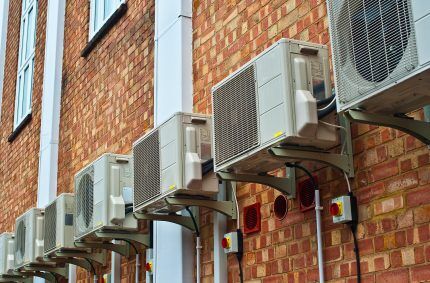
Thanks to the action of the pressure regulator, the boiling point of freon decreases. Once in a special chamber located in the evaporator block, freon expands and “boils,” while intensively absorbing heat and releasing cold. As a result of this process, condensate is released, which settles inside the evaporator chamber on the radiator, through which the liquid is discharged into a special tank. Condensate is discharged from the air conditioning system through a tube.
Absorbing heat, freon again passes from a liquid state to a gaseous state and, under pressure, through a system of tubes is discharged back into the compressor unit, closing the circle of the working process.
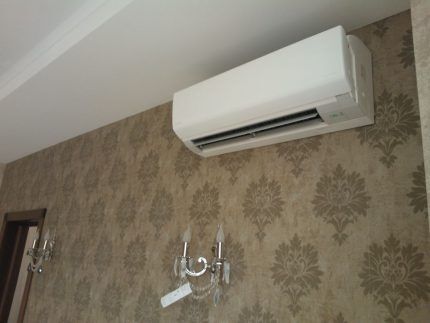
Thus, a closed cycle of refrigerant operation depends on the careful connection of all elements and the elimination of depressurization at the joints and connections of the system.
We talked in more detail about the design and operating principle of household air conditioning equipment in this material.
Also, to ensure the normal functioning of the air conditioner, it is important to choose the right location for its installation. Failure to comply with installation specifications increases wear of system parts and increases the likelihood of operational failures. Installation features will be discussed below in the article.
Technical requirements for installation of blocks
There are a number of rules for choosing a location for installing air conditioning units, but the nuances are not always indicated in the instructions and technical documentation of the equipment, although they are very important during operation. Existing calculations for air conditioning systems require mandatory compliance with a number of parameters during installation.
So, for the indoor unit the following parameters must be observed:
- the distance from the top cover of the indoor unit of the air conditioner to the ceiling, to ensure normal air suction, must be at least 15 cm;
- the distance to the corner wall to which the air conditioner unit adjoins is at least 30 cm;
- the distance to a possible obstacle to the movement of air blown into the room is at least 1.5 meters.
Failure to comply with these technical parameters may lead to disruption of the normal functioning of the air conditioner and increased power consumption.
Also, a lack of air masses supplied for cooling can lead to unstable operation and breakdown of the indoor unit of the air conditioner.
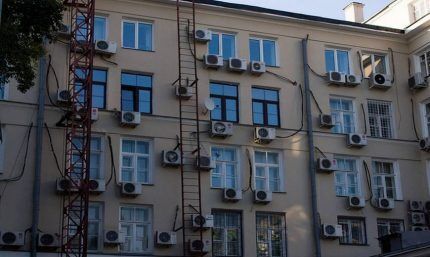
As for the household rules for installing the indoor unit of an air conditioner, when choosing a place where the flow of cold air will be directed, it is necessary to exclude the possibility of a person constantly being there.
Cold air should not enter the place for relaxation (sofa, bed) and place for work (computer or desk). Otherwise, you cannot avoid constant illnesses due to cold air blowing.
To install the external unit, the following parameters must be observed:
- the distance from the rear wall of the external unit to the wall of the building is at least 10 cm, otherwise it will be difficult to “capture” external air;
- maintain a sufficient distance from the ground (when installing air conditioners on the ground floors or in private houses) to prevent snow, dirt, and water from entering the unit;
- install at a distance of at least 1 meter from gas pipes;
- provide at least 1 meter of free space for blowing air with a fan.
The outdoor unit of the air conditioner must be installed on the external wall of the building adjacent to your apartment. You should also exclude the location of the block on the wall of a neighboring apartment. If necessary, provide an external unit special visor — this is necessary to prevent icicles from falling onto the air conditioner unit in winter.
When locating the outdoor unit, it is important to take into account the possibility of free access to it for maintenance.
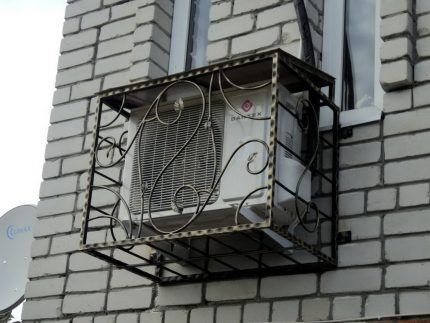
It is worth noting that at the dawn of mass installation of air conditioners in apartment buildings, it was believed that the outdoor unit should be installed lower than the indoor unit. This myth was based on the fact that this is how constant oil lubrication of the outdoor unit compressor will be ensured (otherwise the oil supposedly collects in the indoor unit).
From the point of view of the location of the external and internal blocks, the determining parameter is the distance between them. The established limits are from 1 to 6 meters, but the manufacturer may indicate specific parameters that should be strictly observed.
If the maximum permissible distance is exceeded (more than 6 meters), additional freon will have to be pumped into the system, and if the distance is less than a meter, it is necessary to form a ring from the tube to ensure the required footage.
In more detail the question of the correct choice of the optimal places for installing air conditioner we discussed in our other article.
Air conditioner installation procedure
Even if you install it yourself, you will definitely need help. This is due to the rather large weight of the external air conditioner unit and the work that will be carried out on the outside of the building.
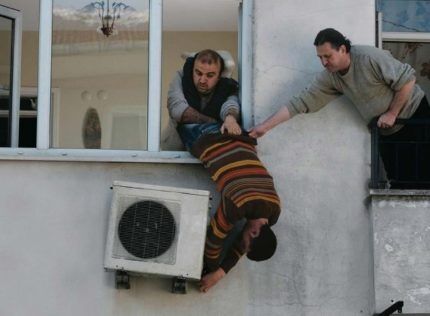
Stage #1 - preparing tools and materials
When installing an air conditioning system with your own hands in an apartment, preparation for the upcoming work plays an important role. The necessary set of equipment, materials and tools used will ensure continuous work on installing the air conditioner.
So, for installation you will need the following tools:
- hammer drill, the main tool for making through holes in the wall;
- a drill with a set of drills, necessary for making holes for fastenings;
- vacuum pump to start the air conditioning system;
- hacksaw or special pipe cutter for copper pipes;
- file or sandpaper for smoothing the surface of the pipes;
- pipe bender to ensure that the pipe system is given the required shape;
- pipe calibrator and flarer;
- wall chaser (or chisel and hammer);
- level;
- screwdrivers;
- set of hex keys.
Self-installation of an air conditioner is impossible without these tools.
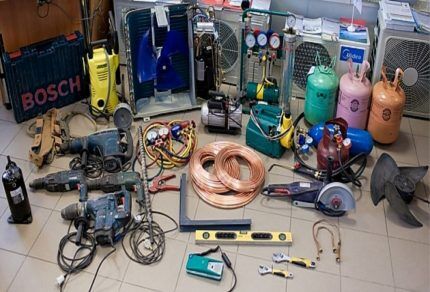
Also, before starting work, you need to prepare consumables:
- power cable for making a power cable and connecting modules - you should use a cable with four cores with a cross-section of 2 x 2.5 mm2;
- seamless copper pipes - their length should exceed the expected length of the route by 50 cm, but the diameter of the pipes is selected in accordance with the instructions for the air conditioner;
- synthetic and insulating insulation;
- corrugated hose with a built-in internal plastic spiral for drainage - its length should be 1 meter greater than the calculated length of the route;
- steel brackets to install an external air conditioner unit - the load limit of the brackets is calculated based on the weight of the unit (you should take brackets that can withstand a load twice as large as the weight of the external unit);
- fastening elements, selected for fastening the bracket and the indoor unit of the air conditioner.
When installing, it is better to use high-quality materials, selecting them directly to your equipment. This will ensure reliability during system operation.
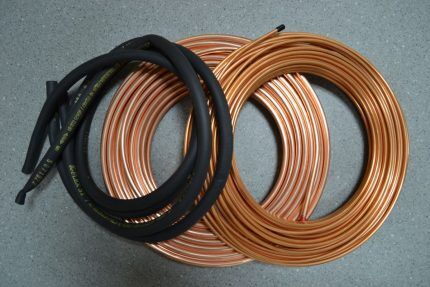
Stage #2 - installation of the outdoor unit
Next, let's look at how an outdoor air conditioner should be installed.
To the above general requirements it is worth adding the following:
- installation must be carried out on load-bearing elements of the building facade or balcony;
- if the walls are made of aerated concrete, then it is necessary to use a damping seal;
- the maximum permissible noise should not exceed 30 dB;
- at installation on the balcony or attic it is worth considering the possibility of vibrations during equipment operation;
- when installed at a height of 3 floors and above, the work must be carried out by high-altitude installers using climbing equipment.
If all these requirements are met, you can begin installing the external unit of the air conditioner.
Having decided on the installation option: on the balcony, under the window or next to the window, you need to make markings using a level. After marking, all the necessary holes are made with a hammer drill - for attaching brackets and wiring the pipe system inside the room - into which anchor bolts are inserted.
It is worth noting that in houses that do not have thermal insulation, the diameter of the hole for air conditioning communication systems should be 50 mm, and where thermal insulation is used, at least 80 mm.
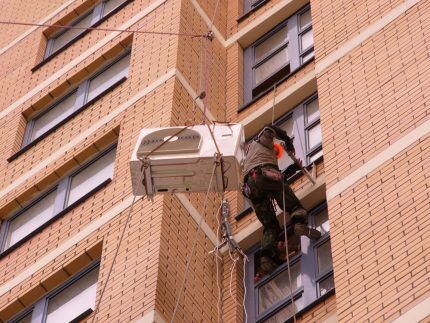
The brackets are secured using bolts, which must be tightened as firmly as possible. It is worth considering that during installation the weight of the outdoor unit can be more than 20 kg, so when installing it you cannot do without the help of a partner.
The external unit is hung on a bracket. First, rubber must be laid at the points of contact between the bracket and the external unit of the air conditioner. It is thanks to this layer that vibration from the operation of the air conditioner will be smoothed out.
Stage #3 - installation of the indoor unit
To install the indoor unit of a household air conditioner, you should also be guided by all of the above requirements. Considering also that the outdoor and indoor units must be installed relative to each other at a distance of no more than 6 meters.
When carrying out work indoors, you must:
- prepare the work area by removing curtains and removing household appliances or furniture from the wall on which the air conditioner will be installed;
- check the availability of the power supply (sockets) to connect an air conditioner to it, if the standard power cable of the device is not enough, you will have to increase it;
- Mount the unit on a wall or ceiling.
In the room in which the indoor air conditioner unit is installed, it is necessary to make markings using a level, then use a drill to make holes in the wall and organize a mount for the air conditioner unit. It is noticeably lighter than the outer one, but, nevertheless, the fastenings should hold it securely.

Insert plastic dowels into the holes and secure them as much as possible with a hammer. Attach the air conditioner mounting panel and secure it with self-tapping screws. Then hang the indoor unit.
Stage #4 - installation of equipment communications
Air conditioner communications include:
- electrical connections;
- piping system;
- drainage system.
When installing an external unit, a hole is made in the wall with a hammer drill, which is called the main channel. It must be of the required diameter so that communications can be passed through it.
For uninterrupted operation of an air conditioner with a power of more than 1.5 kW, it is recommended to install a separate power line. To do this, you need to connect another one to the main panel circuit breaker, from which run a four-core cable directly to the installation site of the air conditioner. When connecting, be sure to determine the zero and phase.
It is worth noting that working with electricity is considered dangerous and should not be performed without knowing the basics of electrical engineering.
We also recommend that you read the rules air conditioner motor connections.
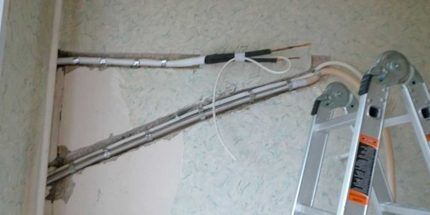
The installation of the pipeline system must be carried out with special care, because a violation of the tightness results in the leakage of life-threatening freon.
Work order:
- the copper pipe is cut to the required length with a margin of 1 m for bends;
- the edges are ground off with sandpaper or a file;
- bending of pipes must be carried out with a radius of at least 10 cm;
- To insulate the pipes, put special polyurethane foam hoses on them;
- flare the ends of the tubes and connect the pipeline;
- After connecting, tighten the fitting flange tightly.
To make the pipe system more tight, professionals advise carrying out soldering copper pipes. Soldering is carried out using a propane heating pad: the pipe is heated to a temperature of 250 degrees and special solder is used.The following soft solders can serve as it: L-SnCu3 (S-Sn97Cu3) and L-SnAg5 (S-Sn97Ag5). They provide reliable fastening, resistance to mechanical stress and corrosion.
Having made the connection between the external and internal units in accordance with the instructions, you should begin assembling the drainage system. The used liquid can be discharged outside the room or into a special container inside the room. It is recommended to arrange drainage outside the premises.
The drainage channel is made of reinforced plastic pipe. It is enough to connect it with a flange to the drain. The liquid drainage pipe must be laid at a slope of at least 3 mm per 1 m.
After completing this work, a corrugation is pulled over the communications outlet from the indoor unit, and the connection must be secured with a clamp. The communications of the external unit are closed with a hose. Possible gaps in the through hole are sealed with polyurethane foam.
We spoke in more detail about the installation of communications in next publication.
Conclusions and useful video on the topic
Self-installation of an air conditioner is clearly shown in this video:
In the same video you can see the most common mistakes made when installing an air conditioner yourself:
Air conditioner installation can be done independently. To do this you need to have a little knowledge and skills. When installing air conditioner units, be sure to follow the instructions and safety requirements. However, when performing work, you cannot do without the help of an assistant - the weight of the outdoor unit can exceed 20 kg.
If, after reading the article, you still have questions or have installation suggestions based on personal experience, be sure to share them in the special comment block below the article. Here you can also add unique photos of your air conditioner installation.




There is a specific proposal: never again show in links people who have an outlet “underneath” and “sawed through with an angle grinder and some water.”